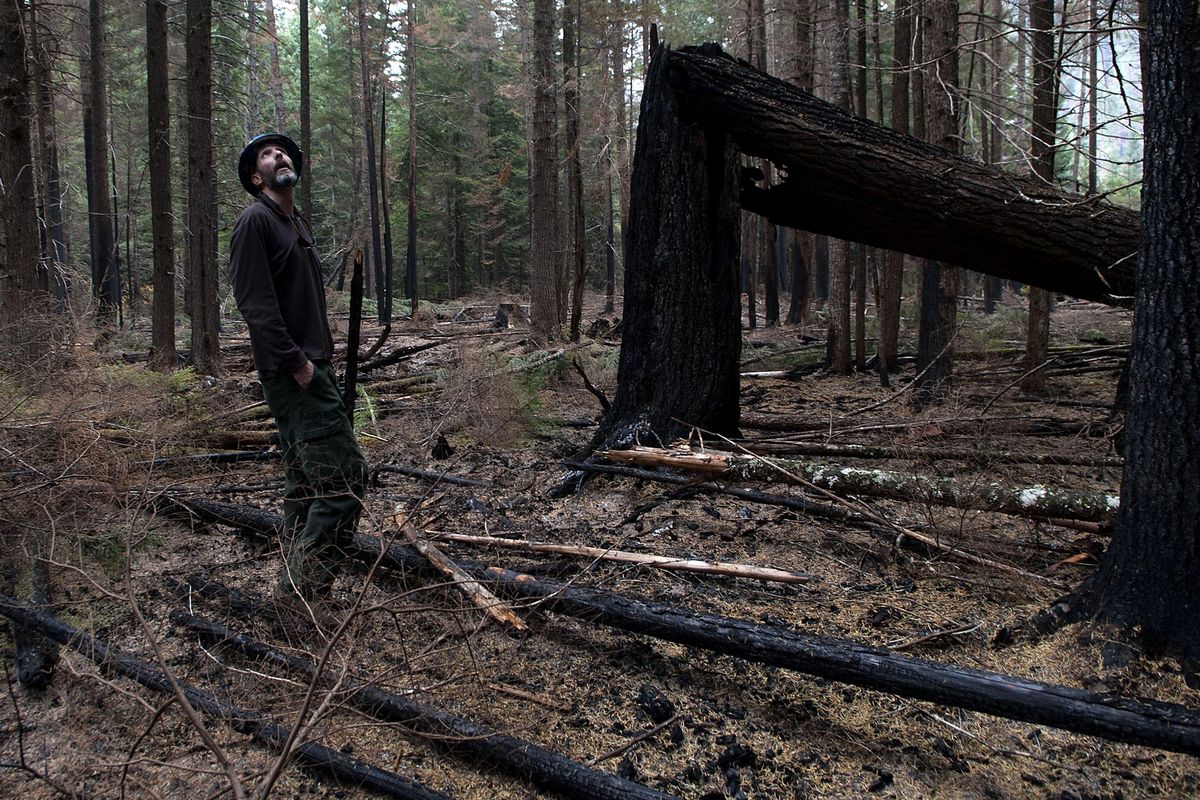Impact of summer wildfires still being gauged by forest experts

PRICHARD, Idaho – Blackened trees scattered showers of bronze needles across a charred landscape.
In the aftermath of one of the Northwest’s worst fire seasons, nature is working to repair itself.
The needles blanketing the forest floor will keep ashy, fire-damaged soils from scouring away when the autumn rains come. By casting their needles, the dead trees are helping ensure that a new forest regenerates on the site, said Jason Jerman, a silviculturist with the Idaho Panhandle National Forests.
“Some people think burned areas look bad,” he said as he inspected scorched hemlock trees north of Prichard. “I find them interesting.”
To Jerman, burned areas often represent potential. This site along the North Fork of the Coeur d’Alene River, for instance, could be replanted with long-lived cedar and white pine trees, which would create a more diverse, resilient forest.
Wildfires burned more than 40,000 acres in the Idaho Panhandle National Forests this summer, and another 93,000 acres in the neighboring Colville National Forest. Firefighting costs topped $89 million.
The acreage burned was among the largest on record for the Inland Northwest since the late 1920s.
“Most people have never seen fire like this here,” said Jason Kirchner, a Forest Service spokesman from Coeur d’Alene. “We saw fire this year that only the old-timers would remember from when they were kids.”
This fall, Jerman and other Forest Service scientists are fanning across the burned landscape to better assess what happened on the ground.
Wildfires can be both a beneficial and destructive presence in the forests of the Northern Rockies, and experts are still trying to get a read on the 2015 season.
As Jerman drove along the North Fork of the Coeur d’Alene River earlier this month, smoke from the still-smoldering Lower Flats fire hung on the hills. The fire is part of the Grizzly Complex fires, which burned a 20,000-acre swath across North Idaho.
Aerial views still show patches of green trees in many areas of the Grizzly complex, but that doesn’t mean the trees escaped the fires, which burned hot on the ground and fried tree roots.
“Some of those trees are dead; they just don’t know it yet,” Kirchner said. “And we won’t be able to tell whether they survived the fire until the flush of green needles next spring.”
The Colville National Forest has the same dilemma, said Franklin Pemberton, the forest’s spokesman.
With enough moisture in their roots, many trees can survive a ground fire. But this year, “it was so dry from the drought, we just didn’t have enough moisture to protect them,” he said. “The roots burned, too. We don’t expect those trees to live.”
In addition to the large number of acres burned, “we saw fire in places I didn’t think would burn,” Jerman said.
The Settler’s Grove of ancient cedar trees, protected from previous fires by its location in a humid creek bottom, lost about half of its inventory in the Grizzly Complex fire. Some of the cedars had survived for 800 years.
Fires are still burning in the grove north of Wallace, and the area will remain closed to the public through the winter to allow hazard trees to fall over.
In the Colville National Forest, high-intensity fires burned through high-elevation stands of lodgepole pine in the Kettle Crest area.
“It’s just moon dust and rock,” Pemberton said. “These are fire-dependent ecosystems – lodgepole pinecones need the heat from a fire to crack them open – but when they burn this hot, it’s not good.”
About 15 miles of the Kettle Crest National Recreation Trail burned this summer, and the trail remains closed due to danger from falling trees.
But in other areas of the Colville National Forest, the burns were lighter, Pemberton said. Those fires could provide future benefits from clearing out underbrush and improving wildlife habitat for elk and other big game.
Both forests saw fire intensity drop in areas where dense stands of trees had been thinned earlier, which was encouraging for Forest Service officials. In the Idaho Panhandle National Forests, the difference was stark: An untreated area looked like a plantation of matchsticks, in contrast to the thinned area across the road, which still had green trees.
“It’s not wall-to-wall black,” Jerman said. “Much of what’s here will survive.”
Both forests expect to put up limited salvage sales to generate some revenue from the burned timber. But most of the future work is aimed at restoring a healthy forest, Kirchner said.
Forest Service officials expect small patches of fire to linger until the region gets a series of soaking rains, or a good snowfall.
“We’ll have fire burning into November,” Kirchner said. “It’s crazy, completely out of the norm. It’s a testament to how extreme this fire season has been.”